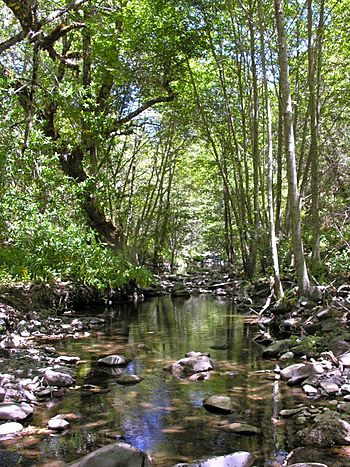Smith Creek (Arroyo Hondo tributary) facts for kids
Quick facts for kids Smith Creek |
|
|---|---|

View upstream of Smith Creek at Mt. Hamilton Road crossing with California bay laurel and white alder, courtesy of Robert A. Leidy PhD, U.S. EPA
|
|
| Country | United States |
| State | California |
| Region | Santa Clara County |
| Physical characteristics | |
| Main source | Northwestern slope of Bollinger Ridge in the Diablo Range 3,520 ft (1,070 m) 37°16′39″N 121°33′41″W / 37.27750°N 121.56139°W |
| River mouth | Confluence with Isabel Creek to form source of Arroyo Hondo 1,585 ft (483 m) 37°23′00″N 121°41′34″W / 37.38333°N 121.69278°W |
| Basin features | |
| Tributaries |
|
Smith Creek is a stream in California that flows all year round. It's about 14 miles (22.5 kilometers) long. This creek runs along the western side of Mount Hamilton in Santa Clara County. Smith Creek starts near a place called Bollinger Ridge. This spot is southwest of Mount Hamilton.
History of Smith Creek
Long ago, a pioneer family called the Winsors lived near Smith Creek. They were some of the first settlers in the area.
Did you know there used to be a hotel called Hotel Santa Ysabel right where Mount Hamilton Road crosses Smith Creek?
Where Smith Creek Flows
Smith Creek begins high up at about 3,520 feet (1,070 meters). It first flows west through a place called Horse Valley. Then, it turns and heads northwest.
The creek gets water from another stream called Sulphur Creek. This happens about 0.8 miles (1.3 kilometers) before Smith Creek crosses Mount Hamilton Road. The Smith Creek Ranger Station is located at this crossing.
Smith Creek continues its journey northwest. It flows along the eastern edge of Joseph D. Grant County Park. Finally, it joins with Isabel Creek. When these two creeks meet, they form a new stream called Arroyo Hondo.
Arroyo Hondo eventually flows into Calaveras Creek. Calaveras Creek then empties into Calaveras Reservoir. After leaving the reservoir, Calaveras Creek joins Alameda Creek. All this water eventually makes its way to the San Francisco Bay.
Animals and Nature in Smith Creek
Smith Creek is home to many interesting animals. One important fish found here is the Steelhead trout. These trout are native to the area. However, a large dam called Calaveras Dam now blocks their path. This means adult steelhead trout cannot swim upstream from the ocean to lay their eggs.
In 1905, a scientist named John Otterbein Snyder studied Smith Creek. He found that both Smith Creek and Arroyo Hondo had steelhead trout. These fish are anadromous, which means they live in the ocean but swim up rivers to reproduce.
Even though there are some waterfalls on Arroyo Hondo, the rainbow trout in Smith and Isabel creeks are believed to be native. Other native fish like California roach and Sacramento sucker also live in these waters.
Sadly, some animals have disappeared. Speckled dace were found in Arroyo Hondo and Isabel creeks in 1905. But later studies in 1978 did not find them. They have vanished from many places along the central coast.
An animal that is not native to the area, the signal crayfish, lives all along Smith Creek. You can also find special frogs here. These include the Foothill yellow-legged frog and the California red-legged frog. They live in Upper Alameda, Arroyo Hondo, Smith, and Isabel creeks.
Rare animals like the river otter have also been seen near Smith Creek. One was spotted in 1999 at the University of California, Berkeley Blue Oak Ranch Reserve.
In 2012, Joseph D. Grant County Park grew bigger. It added 1,157 acres, including 5 miles of Sulphur Creek and Smith Creek. This land was purchased from a famous hockey player, Owen Nolan.


